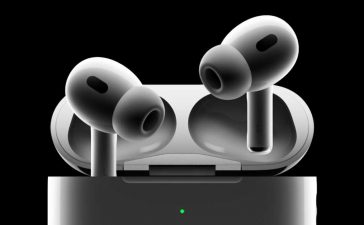DUBLIN–(BUSINESS WIRE)–The “Smart Appliance Market by Technology, Solutions, Applications and Services 2022 – 2027” report has been added to ResearchAndMarkets.com’s offering.
This report evaluates the smart appliance marketplace including technologies, companies, solutions, products, and services. The report includes an analysis of leading companies and their strategies and offerings.
The report evaluates the use of converged AI and IoT systems/solutions known as AIoT to enable intuitive and value-added human-to-machine smart appliance interactions. The report also provides market projections with forecasts covering the period 2022 to 2027 for all major aspects of the smart appliance market including technologies, solutions, applications, and services.
Select Report Findings
- AIoT in home automation market will reach $10.2B globally by 2027
- Smart appliances are evolving to embrace the “as a service” product model
- Combined AI and IoT solutions will drive significant smart appliance market value
- Leading smart appliance vendors are focusing on cloud-based services and improved user interfaces
- The DIY segment for smart home/appliance integration is expected to exceed 47.5% of the total market by 2027
Related to Connected Home technologies, smart appliances leverage the Internet of Things (IoT) and are connected to the Cloud and control infrastructure such as utilities/smart grid to enable more efficient and more productive use of electricity.
Smart appliances include thermostats, clothes washers, dryers, microwaves, hot water heaters, and refrigerators. Smart appliances rely upon various communications technologies including Wi-Fi, ZigBee, Z-Wave, Bluetooth, and NFC, as well as IoT and related operating systems for consumer command and control such as iOS, Android, Azure, Tizen.
Implementation and operation are becoming increasingly easy for end-users, facilitating rapid growth in the Do-it-Yourself (DIY) segment. Smart grid integrators play an important role defining smart appliance standards through transferring knowledge, testing efficiency, and optimizing systems and networks that would communicate with both utilities and smart appliances. These companies and other entities ensure intelligent appliances receive real-time data from the AMI system to control or modulate their operation.
One of the important areas to consider within the smart appliances market is the convergence of AI and IoT, which is also known as the Artificial Intelligence of Things or AIoT. Currently, many AIoT use cases are very retail product-oriented, many of which focus on cognitive computing in consumer appliances.
Sharp refers to AIoT as “People-Oriented IoT = AIoT” for “more responsive technology” as part of what they refer to as the “Smart Life”. They provide examples of smart homes in which the system learns how its occupants like to live through interaction with smart appliances and housing equipment.
Key Topics Covered:
1. Executive Summary
2. Smart Appliances Market Overview
2.1 Smart Appliance Characteristics
2.2 Smart Appliance Market Definition
2.3 Role of Smart Grid Integrators
2.4 Role of Utilities and the Smart Grid
2.5 Smart Appliance Applications
2.6 Smart Appliance Value Chain Analysis
2.7 Designing Smart Appliance Experience
2.8 Context Aware Smart Automation
2.9 Smart Appliance Data Analytics
2.10 Smart Appliances within the Larger Ecosystem
2.11 The Need for Smart Collaboration
2.12 The Need for Companion Capabilities
2.13 Smart Appliance Benefits
2.14 Do It Yourself Case Study
3. Smart Appliance Market Forces and Driver Analysis
3.1 Energy Consumption Continually Increases
3.2 Mobile Application Control and Automation
3.3 Global Housing Market and Economic Factors
3.4 Global Climate and Energy Consumption
3.5 Dynamic Pricing Model Strategies
3.6 Digital Consumerization and Lifestyle Transformation
3.7 High Capital Investment
3.8 Demand vs. Supply Factors
3.9 Competitive Pressures
3.10 Smart City Growth and Development
3.11 Artificial Intelligence
3.12 Waste Reduction Initiatives
3.13 Home Safety and Security
3.14 Home Security and Do-it-Yourself Trend
3.15 Healthcare Integration
3.16 Smart Grid Integration
3.17 Government Subsidies
4. Smart Appliance Companies, Products, and Services
4.1 General Electric
4.1.1 Overview
4.1.2 Products and Offerings
4.2 LG Electronics
4.3 Panasonic Corporation
4.4 Samsung Electronics
4.5 Whirlpool Corporation
4.6 Electrolux
4.7 Philips
4.8 Bosch Hausgerate GmbH
4.9 Haier
4.10 Miele
4.11 Indesit
5. Smart Appliance Market Analysis and Forecasts
5.1 Smart Appliances Revenue Analysis
5.2 Global Smart Appliances Market 2022 – 2027
5.3 Smart Appliances by Type 2022 – 2027
5.3.1 Smart Home Appliances by Type 2022 – 2027
5.3.2 Smart Industrial Appliances by Type 2022 – 2027
5.3.3 Smart Office Appliances by Type 2022 – 2027
5.3.4 Smart Appliances by Communication Technology 2022 – 2027
5.3.5 Smart Appliances by Connectivity Protocol 2022 – 2027
5.3.6 Smart Appliances by End User 2022 – 2027
5.3.7 Smart Appliances by Solutions and Services 2022 – 2027
5.3.8 Smart Appliances by Managed Services 2022 – 2027
5.3.9 Smart Appliances by Support and Maintenance Services 2022 – 2027
5.3.10 Smart Appliances by Region 2022 – 2027
5.4 Smart Lawn and Yard Equipment by Revenue and Units 2022 – 2027
5.5 Smart Lawn and Yard Equipment by Type 2022 – 2027
6. Conclusions and Recommendations
6.1 Recommendations for Appliance Manufacturers
6.2 Recommendations for Technology and Service Providers
6.3 Recommendations for Lawmakers and Regulators
6.4 Recommendations for Retailer Value Chain
7. Appendix: AIoT in Smart Appliances
For more information about this report visit https://www.researchandmarkets.com/r/hrtoqm











